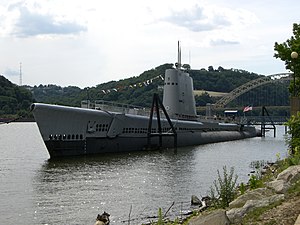USS Requin (SS-481)

The Requin in dock on the Ohio River in Pittsburgh.
|
|
| History | |
|---|---|
|
|
|
| Builder: | Portsmouth Naval Shipyard, Kittery, Maine |
| Laid down: | 24 August 1944 |
| Launched: | 1 January 1945 |
| Commissioned: | 28 April 1945 |
| Decommissioned: | 2 December 1968 |
| Struck: | 20 December 1971 |
| Fate: |
|
| General characteristics | |
| Class and type: | Tench-class diesel-electric submarine |
| Displacement: | |
| Length: | 311 ft 8 in (95.00 m) |
| Beam: | 27 ft 4 in (8.33 m) |
| Draft: | 17 ft (5.2 m) maximum |
| Propulsion: |
|
| Speed: |
|
| Range: | 11,000 nautical miles (20,000 km) surfaced at 10 knots (19 km/h) |
| Endurance: |
|
| Test depth: | 400 ft (120 m) |
| Complement: | 10 officers, 71 enlisted |
| Armament: |
|
USS Requin (SS/SSR/AGSS/IXSS-481) /ˈreɪkwɪn/, a Tench-class submarine, was the only ship of the United States Navy to be named after the requin, French for shark. Since 1990 it has been a museum ship at The Carnegie Science Center in Pittsburgh, Pennsylvania.
Her keel was laid down on 24 August 1944 by the Portsmouth Navy Yard in Kittery, Maine. She was launched on 1 January 1945 sponsored by Mrs. Slade D. Cutter, and commissioned on 28 April 1945 with Commander Slade D. Cutter in command.
Initially, Requin carried heavier armament than usual for a fleet submarine, perhaps because Commander Cutter was one of the most decorated submarine skippers going to sea. She had an additional five-inch/25-caliber deck gun, as well as two 24-tube five-inch (127 mm) rocket launchers, which were intended to be used to provide offshore bombardment during Operation Downfall, the planned invasion of Kyūshū and Honshū.
Following shakedown off the New England coast, Requin departed Portsmouth, on 3 June 1945 en route to Hawaii. She joined the Pacific Fleet on 13 July at Balboa, Panama, and at the end of the month reached Pearl Harbor. However, two weeks after her arrival, three days before she was to begin her first war patrol, World War II ended and Requin was recalled and ordered back to the Atlantic.
...
Wikipedia
